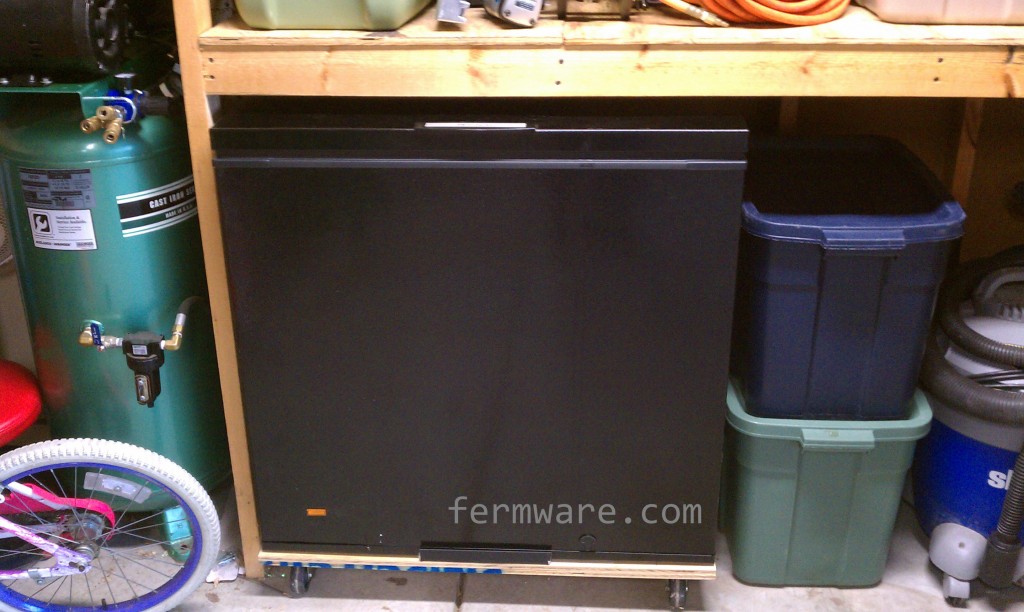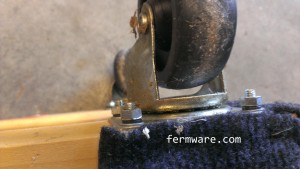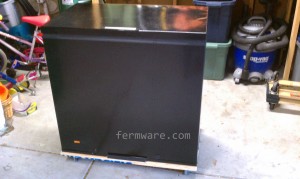An easy way to store your keezer / kegerator under a shelf
Difficulty:  *
*
*Due to the potential of needing help to lift the keezer onto the dolly
Time Required:
one morning or afternoon, plus overnight if gluing the base is required
Background:
As I mentioned in my About: This Blog page, I have limited space for my equipment and the Keezer is no small piece of equipment. It certainly wouldn’t go with the decor of the house and I also didn’t want it to be in easy reach of the kids. Not that they would be drinking it, but I would be concerned they would think it was funny to squirt pressurized beer at will. In my opinion, having the chest freezer sitting on the garage floor with nothing above it was a waste of air space. My ultimate solution was to build a keezer dolly that would allow me to have easy access, but could easily be rolled under a shelf in the garage. It also makes it easy to clean behind it, rolling it to the edge of the garage when defrosting or draining the moisture buildup and is just all around convenient. I’ve had it for 2+ years and it has been great. I’ve also had no issues with it being in the garage and it’s on an outside wall.
My keezer happily in it’s place under a shelf in the garage.
Important note: This would not be wise for a vertical freezer or refrigerator. It could easily tip when moving. This would not be good. Those typically have some wheels anyway.
Affiliate Links
Any links in this post or on this website may link to affiliates, which compensate this website for purchases. All links are provided to help the reader locate items mentioned or used in the post. As an Amazon Associate I earn from qualifying purchases.Parts Required:
- Casters, carriage bolts and nuts/washers
- You could buy a moving dolly for the parts (potentially inexpensive way to get casters and bolts)
- I got mine from harbor freight
- Movers dolly
- I usually pull 20% off coupons from my Road & Track and Car and Driver magazines
- Size / Type
- Big enough to roll over separations in the floor
- Small enough to not raise the keezer too high
- Unless you plan on rolling it into the yard (later post blog, stay tuned…)
- Choose solid rubber wheels. The air filled tires have more resistance on flat surfaces
- The wheels from the Harbor Freight dolly I used are 3″ in diameter and with the casters are about 3.5″ tall
- Plywood sheet
- About 1″ larger than your keezer on all sides
- To use the same bolts from the dolly, make your platform the same thickness of the dolly (more on that later)
- Some type of L-channel (AKA angle iron or L bracket) to help retain the keezer on the dolly
- I used some leftover channel from my garage door opener installation 10 years ago (I knew it would come in handy at some point!)
- You could buy a moving dolly for the parts (potentially inexpensive way to get casters and bolts)
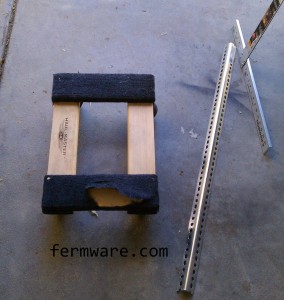
The Build:
Disassemble the dolly to remove the casters (skip to the next step if you just bought them)
- loosen the bolts on the underside that attach the casters to the frame

- If you are using the Harbor Freight dolly or a similar one, you can cut the carpet coating with a knife and peel it off
- push through or hammer the carriage bolts out the other side
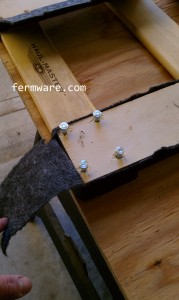
- measure the thickness of the dolly’s frame (important for the building of the platform)
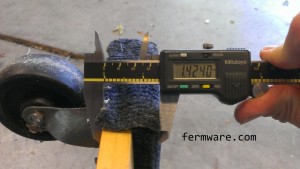
Build the Platform
- Dimensions
- It should be slightly larger than the maximum plan area (top view) of the keezer
- This is so that the first thing that runs into walls is the base, not the handles or hinges
- The sides can be close, but I would overshoot by 1/4″ or so
- Thickness
- If you take a look at the carriage bolts, you’ll notice that they probably aren’t fully threaded
- You want to match the thickness of the platform with the bolts
- Too thin: There will be too much thread extending out
- It could potentially block rotation of the casters
- If this is unavoidable, you could cut them after assembly with a hack saw or your favorite rotary tool
- Too thick: You won’t get enough thread engagement to secure the casters
- Too thin: There will be too much thread extending out
- I simply doubled up the available plywood I had
- cut 2 sheets the same size
- put some wood glue between them
- set something heavy on top and let them sit overnight
Attach the casters
- Choose the location of the casters
- Mark the holes and centers
- Drill the holes with enough clearance for the carriage bolts
- Go slightly oversize on the holes to allow for slop in your drilling and make it less frustrating to assemble
- Put the carriage bolts through the holes (you may need to lightly tap them in with a hammer)
- Secure on the other side with the nuts
Retaining Pieces
- These are to make sure that if the keezer slips on the platform, you won’t push it off the edge when moving it
- you don’t need much length, just enough to catch the keezer on all four sides
- I just cut the piece I had into 4 lengths
- A hacksaw or cutoff wheel will do
- If you want to be really cool, you could get some nuts and bolts to secure them
- I just used some short drywall screws at opposite sides of the outer slots to secure them
- Optional: I covered them with black gaffers tape to match the keezer and make it look nicer
- If you don’t know what gaffers tape is, get some
- It mostly does the same thing as duct tape
- Doesn’t leave residue that duct tape does
- I use it throughout my fermentation process for labels that can be removed and placed on the next vessel in the process. Works for me all the way through kegging.
Finish it up
- You could paint it if you wanted
- Go con / recruit a neighbor / friend to help you lift your keezer up onto the platform
- Pay them with one of your delicious brews
- Be sure to take everything out of it first!!


